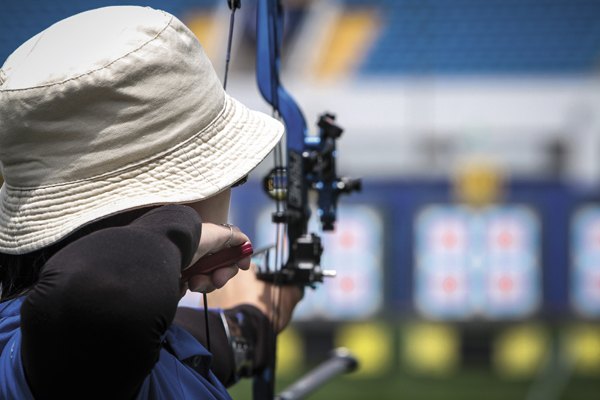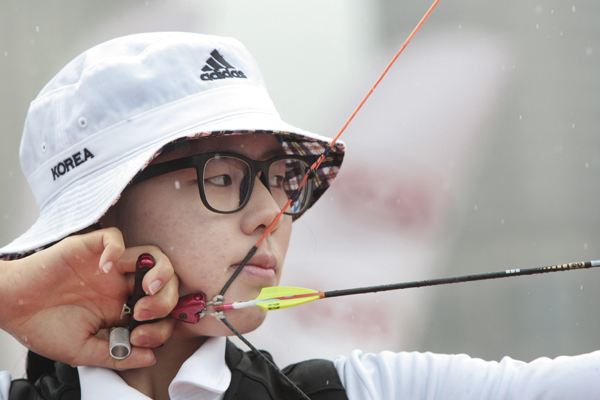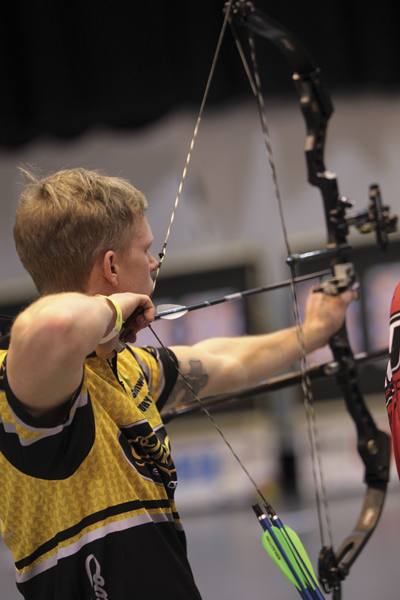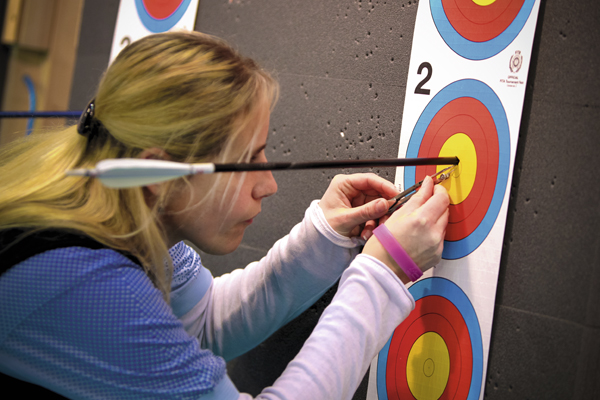Liam Grimwood explains how to achieve the relaxed yet focused aim top shooters use, which can help keep you calm as well as on target

As a rule, the arrow lands where the pin was at the time the bow went off, so the principle of aiming is to get the pin as close to the centre as you can
Aiming is an extremely critical part of the shot. Most compound shooters that have reached a certain level of consistency within their overall technique will know that, as a rule, the arrow lands right where the pin was at the split second the bow went off. So in simple terms the whole principle of aiming should be to get the pin as close to the middle as you can while you execute the shot. The thought process behind this article is to explain how I achieve this goal with consistency, and some of the pitfalls that can come with other approaches to aiming.
Most beginners naturally begin by adopting what I call the ‘manual aiming’ technique. What I mean by this is that they acquire the target in the scope, then consciously try to move the pin onto the centre of the target and hold it there as still as possible and shoot. If it’s a bit low they physically try to push up on it, if it’s a bit high they’ll push down on it, and so on and so forth. In essence, their aiming is manually corrected with a physical movement caused by a conscious decision to move the pin. At some point in everybody’s shooting career they will have certainly adopted this technique, and at times it has probably worked OK as well. But most archers will be able to think back to an occasion where this has not worked so well, and this is because this technique has two major flaws.
The first flaw is that this manual correction often leads to over-compensating, so if the pin is holding left you make the decision to correct and push it right, you push it too much and it ends up out on the right hand side. This manual correction ends up with a game of ‘cat and mouse’. In most the cases the cat can’t catch the mouse and you end up over-aiming, slowing down your shot, and compromising your timing and the rest of your technique.
The second key flaw in this technique is panicking. When your pin makes it on to the middle you know from previous experience that it only stays there for a split second, so you need to get the shot away as fast as possible. You then completely compromise your release and controlled execution in order to get the shot away as quickly as you can. Ultimately, this is a form of target panic, and while it can range from minimal to extreme, my belief is that this catches up with everyone at some stage and this method will hold back your progress and your ability to perform. From experience on the shooting line and as a coach these issues are often exacerbated in a pressure situation.
So if I now have convinced you that ‘manual aiming’ is a bad idea, I want to explain how I do it. I like to call it ‘subconscious aiming’ but don’t worry about the name too much. The best example of how this works in everyday life is in driving a car. When you first started learning to drive it was an enormous challenge to stay between the road lines. You would likely be constantly looking in your wing mirrors to check how far from the line you were on either side, where you would then manually correct and try not to overshoot it on the other side. But now that you have a few years’ driving experience you can simply get in the car, look ahead, and the car subconsciously follows your eye line. I employ this exact same principle for aiming.
The key thought running through my head is to stare at the middle of the target; I then allow the pin to move freely around. If you really concentrate all your attention on the centre of the target, and not on the pin, the pin will move around but its central point of movement will always be the centre of the target. By focusing my attention on staring at the middle of the target and paying no attention to the pin, this keeps me very relaxed and able to carry on with my shot execution, making a good, strong release. What you will find is that to begin with the pin will move around, but its movement will be much more fluid if you don’t force it.
Like any new technique this will take some getting used to, and a big commitment by you to really embrace it and stop trying to manually move your pin. What you should start to notice is that after a few weeks you can start to see patterns in your aiming. Look at how the pin moves; these movements can then be corrected using stabiliser weights or positioning, or even tiller or D-loop configuration. I believe this technique works so well because you remove the conscious thought of getting the pin into the centre of the target. This will help to reduce target panic drastically, and will allow you improve your consistency in technique and shot timing. You should also note that your pin will always move, so the end goal is not to stop it dead. You are trying to get a 10 with every shot, and the 10 ring has some size to it which allows for a certain margin of error; as long as your movement stays within that margin you will shoot a perfect score. Do not become fixated on trying to stop the pin dead still as this will lead to problems – just embrace the movement and keep focused on the gold. As you develop strength and finely tune your setup the movement will become less and less.
I really can’t recommend trying this technique enough – it made a huge difference to my shooting and I am certain it will to yours but, like anything new, give it some time and don’t rush it. If the movement of the pin scares you too much to begin with, you can try and move the target a little closer or try a bigger face size while you become more accustomed to the feel of it.





Awesome advise. I feel the panic as I see my pin off target and struggle to realign it. It is hard to realize that focus on the target will move the pin on target. Exercise, exercise exact.
So many times this advise comes to the surface. It is hard to make it into practice. Believing and seening the shot in your mind also plays into this becoming your shot. Quit forcing it and it happen…. Will it and it will be.
Thank you for the advice. I agree that aiming and attention are really important, although it’s not easy to do so